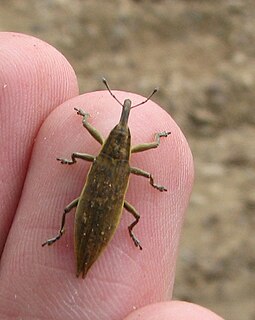
Lixinae is a subfamily of true weevils, included in the Molytinae in many older treatments. They are mainly root feeders, although some develop in flower buds or stems. Several species are used in biological control of invasive weeds, namely knapweeds (Centaurea).

Cyphocleonus achates is a species of true weevil known as the knapweed root weevil. It is native to southern Europe and the Mediterranean and is used as an agent of biological pest control against noxious knapweeds, especially spotted knapweed. It has recently been spotted in India.

Centaurea stoebe, the spotted knapweed or panicled knapweed, is a species of Centaurea native to eastern Europe. It is also an invasive species in southern Canada, and northwestern Mexico, and nearly every state in the United States; it has thrived in the western United States in particular, much of which has a dry climate similar to the Mediterranean. This species and Centaurea diffusa are tumbleweeds — plants that break free of their roots and tumble in the wind, facilitating the dispersal of their seeds.



